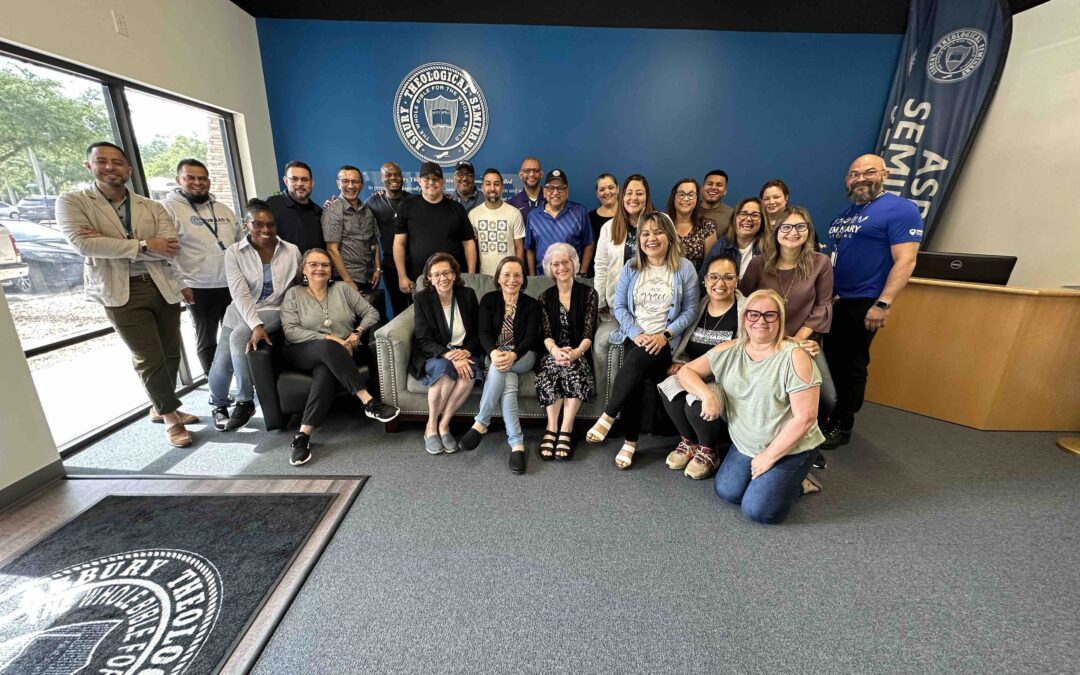Not long ago, I was doing some reflection on the two main seminary courses I teach: Biblical Narrative and Introduction to Inductive Bible Study (IBS, Gospel of Mark). I was thinking about two questions: (1) What do I love about these courses? (2) What does each course offer to students? The Biblical Narrative class offers students, first of all, a new grasp of The Story, which gives greater clarity to their understanding of the biblical stories. Second, through an introduction to Lectio divina, the course also offers them a new way of engaging with the stories as attentive listeners and not just pragmatic readers in search of material for the next sermon. In the IBS course, once students get past the initial steep learning curve and can catch their breath a bit, they find an almost daily dose of “aha!”, as they begin to see the text with fresh lenses and new tools.
I love walking alongside students in all of these learning journeys—and I love that doing so keeps me attentive to new insights from the text and from the Spirit who inspires the text. This was true in a recent encounter with Mark 5:25–34.
Most of my encounters with this passage in the past have focused on the woman—her excruciating experience of chronic illness, her desperate, last-ditch courage, her healing. But this time, after having done extensive IBS work with the passage alongside my students, I sat with it in a Lectio exercise, and the Holy Spirit highlighted something else. Clearly and gently, my attention was nudged away from the woman toward Jesus, and especially toward his question in v. 30.
“Who touched me?” In that moment I realized that Jesus’ question had always sounded in my mind as if it were spoken in a slightly accusatory tone. But as I sat in attentive silence with Jesus’ question, it suddenly sounded like an invitation, a warm verbal embrace. And yes, I think the previous IBS work with structure and context prepared me to hear this. Mark 4–8 is a veritable zig-zag of lake crossings—back and forth from the Jewish side to the Gentile side. It probably felt dizzying to the disciples! Mark makes it clear, in a host of little ways, that Jesus directed these geographical moves in a purposeful way, so we can be pretty sure that just as Jesus meant to meet and heal the Gerasene demoniac on the east side of the lake, he also meant to encounter and heal this woman on the west side. He was not surprised or mystified by her actions or her condition. And there in his question was an extravagant invitation for her to come fully into his presence. There’s a sort of sub-text here, like a divine heartbeat: “I’m so glad you touched me! Come and tell me all about it!”
Jean-Louis Chrétien (Under the Gaze of the Bible) suggests that we approach Scripture in ways that will allow ourselves to be read by it, a reading that requires something of us, demands vulnerability of us, allows the truth to stop us in our tracks, and is filled with lively patience and active self-discipline that relinquishes our arrogance.[1] Such a reading means that new insights into the text are likely to come accompanied by questions that we must confront. The first such question arose from hearing Jesus whisper “Who touched me?” as an invitation. In what ways is Jesus inviting us to touch him today, to break free of whatever holds us back from bold intimacy with him? How is he welcoming us into his presence, calling us to “come clean and come into the open,” so that we can “fall down before him and tell him the whole truth,” as the woman did (Mark 5:33)?
The second thing the Holy Spirit highlighted was not in the text but in me. I had to face the question: Why did I always hear Jesus’ words as if they were spoken in an accusatory tone? What had shaped such a hearing? Was that way of hearing of Jesus’ question coherent with The Story, especially in its Gospel shape? The personal answers to those questions are fodder for another essay on another day! But there is a corollary set of questions for each reader of Scripture: what unexamined assumptions and ideas do we bring to our engagement with the Bible? What do we think we know that keeps us from seeing what is really there? Will we allow the Holy Spirit to help us identify those things?
In verse 34, another new insight surfaced. Jesus says to the woman: “Daughter, your faith has healed/saved you”; that’s in the perfect tense in Greek, communicating that it is an accomplished fact. (She’s already realized this, v. 29.) Then immediately Jesus says, “Go in peace and be healed of your disease”. This is in the present active imperative, which conveys a sense of persevering continuity—“keep on being healed.” The miracle, while fully accomplished by the power of God, was not all that Jesus had to offer her! There was more! Her new life had just begun—now came the adventure of living into it, of experiencing more and more of the healing power of Jesus. It struck me that this is a beautiful picture of salvation—the new birth is a radically powerful beginning, but there is more! The process of our sanctification—being conformed to the image of Christ—is the real adventure!
A fuller version of this essay appears on Rachel’s blog: WritePrayLove.
[1] See the discussion in Craig G. Bartholomew, The Old Testament and God: Old Testament Origins and the Question of God(Grand Rapids, MI: Baker, 2022), 129–130.

